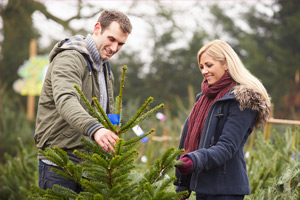Our companies are backed by the Best Pick Guarantee. Call one today!
Christmas Tree Safety: How to Choose, Care For, and Chuck Your Tree
December 2nd, 2013 byArmchair environmentalists who pined for a resolution to the debate over natural versus artificial Christmas trees now have their answer.
Research shows that natural trees, which cause one-third less carbon emissions than the production and transportation of artificial Christmas trees, are definitively the better choice.
But along with their smaller carbon footprint, natural trees come with added responsibilities. There’s obviously more variability among natural trees than artificial trees, so natural trees must be carefully selected.
After being harvested, the trees must be tended to in order to keep them spruced up, and when it’s finally time for their long winter nap, they must be properly disposed of. Here are a few simple steps for finding the right tree and maintaining it until the season’s through.
Choosing a Precut Tree

There are many different species of Christmas trees, several of which have distinctive benefits.
- Scotch Pine has traditionally been the most popular species due to its strong branches and ability to retain its needles even under dry conditions.
- Fraser Fir is also a durable tree, and it’s particularly known for its strong, long-lasting aroma.
- Blue Spruce, with its characteristic color and natural symmetry, is an increasingly popular species, but its needles are relatively sharp, making it a bad choice for homes with very small children.
- Leyland Cypress is a sap-free species and a good selection for allergy sufferers.
Whichever species you select, remember to measure the height and width of the space the tree will occupy before you leave the house.
If you get back and the tree doesn’t fit, it will take a lot of ornaments to cover up your ad-hoc tree surgery. Don’t forget to take into account the height added by your tree stand and tree topper.
Other than its size, the health of the tree is the most important consideration. Precut trees should be inspected to be sure they’re hardy enough to make it to New Year’s.
Check the trunk to confirm there are no splits, and run your hand along a branch to guarantee the needles are fresh and flexible. Bump the base of the trunk against the ground; if either green or brown needles fall off, the tree is not fresh, and you should choose another.
Don’t be afraid to ask an attendant to unbale the tree so you can look for bald spots; Christmas trees can be expensive, so you want to make sure you get your money’s worth.
Caring for Your Tree
When it comes to Christmas tree care, keeping the tree moist is the only priority. First, if your tree was precut, help it put its best foot forward by getting a saw and cutting a half-inch slice from the base.
If it’s been more than six to eight hours since the tree was harvested, the base of the trunk will have become dried out, making water uptake more difficult.
Next, put the tree in a tree stand with plenty of water, and disregard folk wisdom that recommends mixing in aspirin, soft drinks, or molasses—according to research, water additives are simply ineffective.
Lastly, keep the tree away from floor vents, wood stoves, fireplaces, and other heat sources that will make the tree dry out faster.
Chucking Your Tree

Once Christmas is over, many people are eager to dispose of their trees in dramatic, cathartic ways. EBSCO Research recommends an environmentally friendly approach—after all, real trees are biodegradable and can easily be recycled.
In the post-holiday weeks, many sanitation departments add curbside Christmas tree pickup to their regular recycling schedules, and plenty of environmental organizations publicize Christmas tree recycling events.
Ultimately, the trees will be chipped and used as mulch, often for municipal projects such as playgrounds and public landscaping.
Christmas can be a stressful time of year, but all in all, choosing, caring for, and disposing of a tree should be fun and easy. Simply pick a healthy specimen that appeals to you, and make sure it stays well watered.
After the holiday, the jolly feeling that comes with getting rid of your tree responsibly is an added bonus—and a good way to start the new year.


























